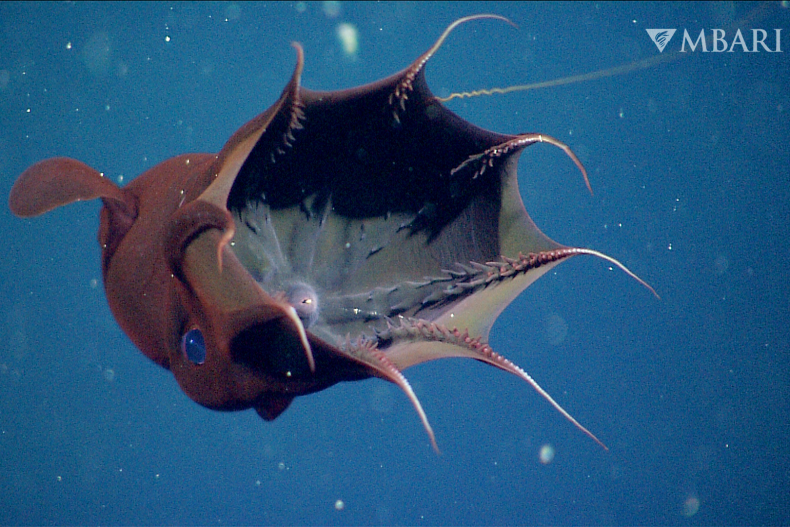In the deep ocean, thousands of feet below the surface, lives a mysterious creature with a name befitting Halloween—the vampire squid.
The scientific name of this species, Vampyroteuthis infernalis, which means “vampire squid from hell” in Latin, seems appropriate given that it lives in darkness, has a deep red body, and a cloak-like web that extends between its eight arms.
Modern day vampire squids are almost unchanged from their ancestors that lived hundreds of millions of years ago, and as a result have been dubbed “living fossils” by scientists.
Despite their name and appearance, they are neither squids nor octopuses, but instead belong to their own order of cephalopods—the group of molluscs that contains all these animals, as well as cuttlefish. They are the only known surviving member of their order, which is called Vampyromorphida.

“They represent ancient cephalopods before the split into octopuses and squids,” Bruce Robison, a senior scientist at the Monterey Bay Aquarium Research Institute, told Newsweek.
“They have eight arms and two long, slender filaments, not found in other cephalopods, that they deploy from pockets between the arms,” Robison said. “They use the filaments to collect food particles and they may have sensory functions as web. Between the arms is an umbrella-like web that probably led to it being named for a vampire because it can look like a flowing cape.”
On the insides of the arms, these animals have suckers, near the tips, as well as series of strange, finger-like projections called cirri.
The vampire squid, which can grow to sizes of around 12 inches, was first described in 1903, although researchers originally classified it as an octopus. But despite the fact that these deep sea creatures have been known for more than 100 years and have a wide geographical distribution, they are rarely seen by humans.
These animals are found in temperate and tropical regions of the Pacific, Atlantic and Indian oceans but they live so deep that few people ever encounter them.
“Among those of us who are lucky enough to explore the deep water column, seeing a vamp during one of our dives is an infrequent and happy event,” Robison said. “Even when they were the specific target of a research project, we could never be certain of finding one when we needed to. They are solitary animals and are sparsely distributed in the vastness of their preferred habitat.”
Vampire squids prefer deep, dark, cold habitats—typically between around 2,000 and 3,000 feet down—where the oxygen concentration is quite low, according to Robison. They have several characteristics that make them well-suited to this environment.
Vampire squids are neutrally buoyant and they have very low metabolic rates. These adaptations reduce the need for investment in muscle tissue for locomotion and save energy. Their dark appearance reduces their visibility to predators and, therefore, the need for rapid escape capabilities.
“They are perfectly adapted to the conditions of low temperature and reduced oxygen because they have low metabolic rates, languid behavior, and a very efficient system for extracting oxygen from the water they inhabit,” Robison said.
“Their habitat protects them from many would-be predators because the conditions there are difficult for most other animals to survive in. That also means that many potential prey species are excluded as well.”
One of the most distinctive features of this species that has helped them adapt to the darkness of the deep is their large eyes, which are a “beautiful” blue in Pacific specimens and apparently red in the Atlantic, according to Robison.
“We don’t know yet if there are more than the single species that was described back in 1903,” Robison said. “I think that there are a couple of research groups trying to resolve that question with genetics. They occur off both the Pacific and Atlantic coasts of North America and superficially they look different but so far only one species is recognized.”
One of the most “spectacular” aspects of the vampire squid’s behavior, according to Robison, is its use of bioluminescence.
“They have a large light-producing organ near the base of each fin that they can open and close like the iris of a camera. They have a luminous organ at the tip of each arm. And they have pores on their arms that can secrete a luminous fluid,” Robison said.
“When seriously threatened a vamp will turn on the fin and arm-tip lights and sweep its webbed arms up over its body, while expelling luminous fluid. This radically changes the appearance of the animal while creating a grand fireworks display that probably serves to distract or confuse predators.”
Despite the paucity of other animals at the depths in which it lives, the vampire squid is able to thrive by feeding primarily on “marine snow”—a mixture of detritus, such as dead animal material, feces and mucus, which sinks downwards from the water above. This feeding strategy has not been documented in any other known cephalopod.
While it has few predators, there are some animals that do feed on the vampire squid, such as toothed whales, which like other whales are not affected by the low oxygen concentrations at the depths where Vampyroteuthis occurs because they breathe at the surface. Some large fish and squid also make feeding forays into low-oxygen waters to feed on this species before quickly exiting.
The vampire squid is one of millions of species that live in the deep ocean, most of which have never been seen or described by humans. But while these creatures inhabit deep waters, they are not totally shielded from human activities and face several threats.
“We find plastic fibers and particles in their stomachs, and by warming the ocean we change the productivity of the surface waters that the deep-sea food web relies upon for sustenance,” Robison said. “Industrial activity in the deep ocean fouls the water and reduces the habitability of even the deep water column.”





